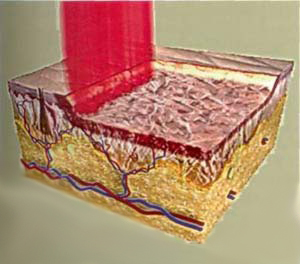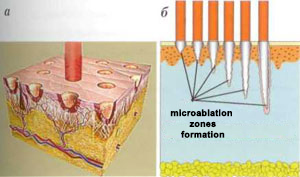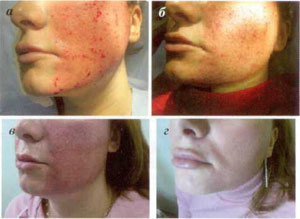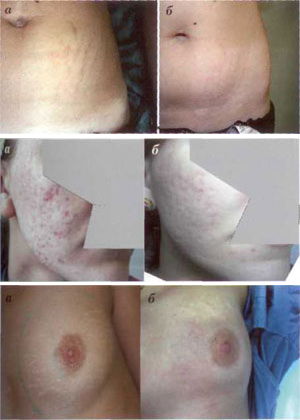Today, in the arsenal of modern dermatology, there is a fairly wide range of methods for correcting various aesthetic skin defects - chemical peels, mechanical dermabrasion, laser peeling, microdermabrasion, peripheral plastics, and others. However, new trends and technologies in the beauty industry are constantly evolving and improving.
This trend is particularly typical for instrumentation methods, particularly for laser medicine. The use of lasers, first in dermatology, and then in cosmetology, has a remarkable period. Even since the emergence of one of the most recent methods of laser therapy - selective photolysis - more than 25 years have passed. The pioneers of this trend, Americans RR Anderson and J. A Parrish, predetermined the fate of fractional lasers in medicine, making them indispensable in treating such aesthetic skin defects as capillary angiomas. Port wine stains, hypertrichosis, tattoos, rosacea, pigmentation disorders, photoaging, wrinkles, etc.
New technologies for skin reshaping
We live in a time when more people are living to old age than ever before. Given that many of them continue an active life, one of the most important problems in aesthetic medicine is the fight against aging of the skin.
Plastic surgery is able to rejuvenate the shape of the face by removing excess skin. However, at the same time, the skin can still change over time (age-related aging) or external factors (photoaging). It is also important that most patients want to look younger without surgery.
In this case, what method should be used to affect the skin and what should happen in it for its true rejuvenation?
All methods that can be used to improve the appearance of the skin are united by one principle - they use a painful effect on the skin, which leads to fibrosis, which leads to its tension and pressure.< / pixel >
Currently, dermatology and aesthetics use three main types of reshaping effects on the skin, including:
- Chemical Stimulation - Chemical Peeling with Acids (Trichloroacetic, Glycolic, etc. );
- mechanical stimulation - mechanical dermabrasion, micro-peeling, mesotherapy, fillers, sub-needling;
- Thermal Stimulation - Laser ablation, thermoplasticity with laser and broadband light sources, radiofrequency elevation, and partial methods.
chemical stimulation
Historically, acid peels were the number one method for skin rejuvenation. The principle of partial peeling (as with superficial peels) or almost complete (as with middle and deep peels) destroys the epidermis and damages the fibroblasts and dermis. This damage activates an inflammatory reaction (the higher the strength, the greater the size of the destruction itself), which leads to additional production of collagen in the skin.
However, in order to achieve the desired result, peeling has to sacrifice the complexion. Many have been misled by the burn experiences, claiming to "prove" that skin is a self-regenerating organ that recovers quickly on a damaged area. In this regard, peels became even some time more aggressive towards the skin (for example, deep phenolic peels), until finally the accumulated problems made specialists realize just how dangerous this is, a method that ultimately leads to skin thinning. Supporters of deep peeling ignored the emerging problems. Their essence was that due to the destruction of the papillae in the dermis and poor nutrition, the epidermis becomes thinner, and the number of cells in the stratum corneum is significantly reduced compared to what was before the peeling. The decrease in the protective barrier function of the stratum corneum leads to reduced skin hydration. (Therefore, almost all patients after a prolonged deep peeling experience severe dry skin) At the same time, the lighter peeling application (using trichloroacetic acids and fruits) has fallen short of their hopes of effectively tightening the skin. Among the methods of mechanical stimulation of involuntary changes in the skin, dermabrasion with rotary devices (at v speed; rotation of incisors up to 100, 000 rpm) deserves special attention. Currently, modern Schumann-Schreus (Germany) devices are used This method can only be used in a surgical hospital, because the procedure requires anesthesia, post-operative treatment of the wound surface, a special toilet for eyes and mouth, as well as a feeding device. Patients (due to the fact that the pronounced edema after surgery that occurs 2-3 days after the procedure makes it difficult to open the eyes and mouth). This method is very effective, but unfortunately, with mechanical dermabrasion, there is a high risk of complications such as:< / pixel > All of the above specify the limited application of this method in clinical practice. Genetic Redesign Since the late 1980s, lasers have been used to rejuvenate the skin by removing tissue layer by layer (excision) [4]. Precise and low-traumatic removal of the surface layer of the skin using the carbon dioxide laser stimulates the formation of its collagen, the amount of which increases several times after the operation. Then it is gradually realigned. was most effective with the use of the carbon dioxide laser, when exposed to a deep thermal effect on all layers of the dermis, externally manifested through the tightening effect of the skin. This method is called a “dermal laser” or “resurfacing” laser, and in terms of efficiency it cannot be opposed by any other method of skin rejuvenation that was in place at the time (Fig. 1). < / pixel > However, the CO laser also causes a large number of complications. In addition, other studies have shown that such a profound effect on the dermis stimulates fibrous tissue formation to a greater extent which contributes to new normal synthesis. Directed collagen [5]. Progressive fibrosis can make the skin appear abnormally pale. The synthetic collagen is reabsorbed after treatment after a few years, as any collagen forms at the site of the scar. As a result of the thinning of the epidermis resulting from the atrophy of the papillary layer of the dermis, fine wrinkles begin to appear on the skin. Due to impaired barrier function of the stratum corneum, the level of skin hydration decreases and appears atrophied. Erbium, Aluminum, Yttrium-Agate and Erbium lasers appeared somewhat later. The advantages of the Erbium laser such as a shallow thermal penetration depth (the erbium laser penetrates to a depth of 30 μm, the CO laser - up to 150 μm) and (as a result) the lower risk of burns and tissue carbonization, as well as the relative cheapness (compared to the CO laser), attractThe attention of many professionals around the world. However, with the accumulation of experience working with these two types of formulations, an opinion arose among specialists that the CO laser is more efficient [6]. Despite the negative effects of carbon dioxide laser dermabrasion described above, this method is indispensable for correcting acne scars. In addition, it can be considered an alternative to surgical skin tightening - of all methods of reshaping it, only exposure to the carbon dioxide laser can cause collagen shrinkage with a pronounced clinical tightening effect. < / pixel > The problem with all of the methods described above is that they often "sacrifice", that is, they cause significant damage to the skin. In order to rejuvenate your skin and look really young, you need perfect and natural complexion dermis papillae, good hydration, natural skin tone and elasticity. Skin is a highly specialized organ, up to 200 microns thick, that is our only defense against the effects of negative environmental factors. Hence, whatever we do to rejuvenate skin, we need to make sure its natural infrastructure is never damaged. This concept contributed to the emergence of the non-ablative skin reshaping technology. Unquoted Replay The most popular non-surgical skin reshaping devices are neodymium (Nd-YAG) and diode lasers, as well as broadband (IPL) light sources. The principle of its action - selective photolysis - is to heat and destroy structures containing a sufficient amount of melanin or oxyhemoglobin. In the skin, they are accumulations of melanocytes (freckle, melasma) and microvessels (telangiectasia). The emitted wavelengths used in non-ablative lasers correspond to the maximum absorption spectra of oxyhemoglobin or melanin. The treatment procedure with non-ablative laser and IPL is completely safe, the rehabilitation period is minimal, however, this treatment only removes pigmentation and vascular and cosmetic defects. In this case, there is a certain thickness of the skin, but the effect obtained is short-lived. < / pixel > The constant search for new methods that are highly effective and safe at the same time for skin rejuvenation has given rise to a revolutionary technology - fractional conduction of laser radiation. The proposed skin regeneration method is specially designed to overcome some of the above mentioned difficulties. Unlike ablative and non-ablative laser methods, which are designed to achieve uniform thermal damage to the skin at a specific depth, fractional methods allow to achieve selective microscopic thermal damage in the form of many variable columns and leave unaffected areas around these delicate wounds. The industry currently produces two types of fractional lasers: non-fractional. The first uses an erbium-doped optical fiber that generates radiation with a wavelength of 1550 nm. Fractional laser creates thousands and tens of thousands of microscopic disruptions in the skin in the form of columns - Precision Heat Treatment Zones (MLZ) - with a diameter of 70-150 mk depth of up to 1359 mmmechanical stimulation
Thermal Stimulation
 < / pixel >format. 1. The traditional laser skin peeling scheme (laser dermabrasion)
< / pixel >format. 1. The traditional laser skin peeling scheme (laser dermabrasion)fractional skin reshaping techniques
This technique - fractional photolysis (FF) - is a very effective method of non-ablative partial skin reshaping. To achieve the desired effect, a course treatment is prescribed. Depending on the clinical condition, it is recommended to carry out 3 to 6 procedures with an interval of 4-6 weeks. As with any other non-surgical skin reshaping method, the final result can only be seen 4-8 months after the procedure (cumulative effect). < / pixel >
 < / pixel >
< / pixel >
In cases requiring a more aggressive effect on the skin - to correct scars, remove deep wrinkles and augment the skin, the partial excision (FA, or partial resection of the skin) method is usedDeep - FDDA).
The fractional ablation method combines the advantages of a carbon dioxide laser with the principle of partial laser radiation delivery. In contrast to the conventional CO laser, which removes the entire skin surface layer by layer, the FA units form a large number of fine MAL regions (MALs) up to 300 μm in diameter at an evaporation depth of 350 to 1800 μm (Fig. 2).
and so on. During this procedure, the laser radiation penetrates the deeper layers of the skin and damages the top layer of the epidermis. In terms of efficiency, laser fractional regeneration can be compared to plastic surgery, this is how deep the laser beam floats to the surface.
Form. 2. The principle of operation of the ablative fractional laser: formation of microplate regions - MAZ (a); the dependence of the depth of formation of the MAZ on the laser radiation strength (b)As in the case of FF, 15 to 35% of the skin of the treated area is actually exposed (in some cases, up to 70%). Recovery after an FA procedure is faster than a laminectomy. This is due to the fact that a largepart of the epidermis and the stratum corneum remains intact. Skin bleeding is noticed for some time immediately after the procedure, but soon stops (Fig. 3a, b).< / pixel >format. 3. Step-by-step skin repair after a resection procedure: see immediately after treatment (a); every two days (b); after 5 days (c); 14 days (d) after one procedure
Several microscopic hemorrhages appear in the dermis, resulting in a complex series of changes that lead to the production of new collagen. After the bleeding has stopped, it is necessary to remove the serous fluid remaining on the surface of the skin. Its release is observed within 48 hours after the procedure, until complete epithelial shedding of the microbial areas occurs. During this period, the patient uses special external agents to heal wounds. It usually begins 3-4 days, and peeling and swelling increases (Fig. 3c). By the seventh day, these phenomena gradually subside, and erythema remains the only observed side effect (Fig. 3D). The duration of erythema depends on the parameters of exposure to the laser and the characteristics of the cutaneous vasculature. According to the author's observations, erythema does not last longer than 3 months. < / pixel > Patient's loss of social activity 5 to 10 days after the FA procedure. To prevent scarring and post-inflammatory pigmentation, careful skin care is essential. Decorative cosmetics can be used in 4-5 days. The prerequisite for a good result is to use it for at least 3 months after applying sunblock cosmetics with a high degree of protection (SPF 50 at least). Post-inflammatory pigmentation risk occurs in 20% of patients and is generally higher in IV-V skin patients. This hyperpigmentation is transient in nature and can last from 1 week to 3 months, which also depends on the depth of treatment and the area of the treated area. To prevent it from one to two weeks before the procedure, duringand after another two weeks, external agents based on hydroquinone (4%) and tretinoin (0. 1%) are prescribed. The main effects on facial skin after the FA procedure are as follows: pronounced tightening and reduction of excess skin, surface smoothing, wrinkles of the skin, as well as skin affected by acne scars, reduction of discoloration, and porosity. < / pixel > This method was also tested by the author and colleagues to remove stretch marks. As shown by clinical studies, the method has proven highly effective in eliminating almost all types of stretch marks, both of which are acquired in the puberty period and the postpartum period. It has been observed that the healing processes on the skin of the body differ from those on the skin of the face. Let's consider the mechanisms of skin remodeling when using a fractional laser. After exposure to the laser, aseptic inflammation occurs in the area of the formed micro-wounds. The more aggressive the laser exposure, the more pronounced the inflammatory response, which, in fact, stimulates the release of posttraumatic growth factors and infiltration of damaged tissues by fibroblasts. The upcoming reaction automatically coincides with a surge in cellular activity, which inevitably leads to the fact that the fibroblasts begin to produce more collagen and elastin. The skin reshaping process includes three classic stages of regeneration: It should be noted that all three stages of skin remodeling are observed after partial photolysis and after partial resection. But in the first case, the harmful effect of the laser is moderately aggressive, and as a result, a series of inflammations change is never unruly. A completely different image is observed after exposure to a partial ablation laser. The shock caused by this laser ruptures the blood vessels, and the blood cells, along with the serum, are released into the surrounding tissues. Full-fledged mechanism of skin regeneration - initiation of pha change - development of aseptic inflammation. Platelets released from damaged vessels play an important role in stimulating blood clotting and releasing chemical toxic agents that, in turn, are attracted to other platelets, leukocytes, and fibroblasts. Leukocytes, in particular neutrophils, are involved in the cleansing of destroyed tissues, removal of dead tissue fragments, which are partly damaged by phagocytosis, and partly exude to the surface of the skin in the form of microscopic debris consisting of substrates of epidermal and dermal tissue and melanin - debris micro-necrosis of the epidermis (MENO). < / pixel > The reproductive phase begins in about 5 days. During this period, the neutrophils are replaced by monocytes. Monocytes, keratinocytes, and fibroblasts continue to influence growth factors and at the same time are under their opposite influence. Keratinocytes stimulate epidermal growth and release of growth factors needed to stimulate the production of collagen by fibroblasts. At this stage, new blood vessels are formed, and the extracellular matrix is intensively formed. The final, reconstructive, healing stage after fractional laser exposure lasts several months. By the fifth day after injury, the fibronectin matrix "fits" along the axis along which the fibroblasts line up and along which the collagen will be built. An important role in the formation of this matrix is played by the conversion of growth factor (TGF- a strong chemical agent toxic to fibroblasts), as well as other growth factors. The main form of collagen in the early stage of wound healing is Type III collagen (this type of collagen is located in the upper layer of the dermis, below the basal layer of the epidermis). The longer the change phase, the more type III collagen will be produced, but in any case, the amount increases to a maximum 5-7 days after damage. Type III collagen is gradually replaced by collagen over the course of about a year, Type 1 which strengthens the skin. Blood circulation is gradually normalized, the skin becomes smoother and acquires a natural color.< / pixel > Summarizing the above, below is a diagram showing the relationship between the efficacy and safety of laser skin resurfacing techniques. Advantages of partial path renewal methods. Advantages of the partial methods used in clinical practice include:
skin reshaping mechanism when using fractional laser
Comparative analysis of laser methods of skin reshaping
Principal Parameters of Partial Transactions
 Partial Thermolysis Indicators:
Partial Thermolysis Indicators:
- Increase skin density in the early stages of aging. The FF procedure is relatively easy and can be performed without fear. The curative effect can be exerted on the neck, chest, arms, abdomen, thighs and mammary glands.
- skin aging;
- Hyperpigmentation, melasma;
- Hypertrophic Stigmata;
- Stretch marks.
partial ablation indicators:
- wrinkles of varying intensity - from fine lines to very clear (in the form of grooves);
- Age-related loss of skin elasticity and firmness;
- Excess skin on the eyelids, neck, and face (as an alternative to plastic surgery);
- The skin texture is not homogeneous;
- Signs of photoaging skin appearing;
- acne scars;
- Scar deformation of the skin after injuries and operations;
- Hyperpigmentation: Melasma, lens, macular pigmentation, etc.
- vascular chromatic dysfunction;
- Stretch Marks
- Actinic keratosis.
In conclusion, a few words about the prospects for the use of laser technologies in aesthetic medicine. We should pay tribute to the manufacturers who have begun to pay more attention to the safety of medical procedures with lasers. Technology that is constantly evolving. However, the safety of the method is often sacrificed in order to increase its effectiveness. Or vice versa. A compromise was found in a new principle of delivering lasers to tissues. It should be noted that the types of lasers remain the same: erbium, carbon dioxide, and neodymium. This indicates that:
- First, laser skin reshaping is the most effective today;
- Second, the coverage of aesthetic and dermatological problems solved by these methods is quite large - from skin rejuvenation to treatment of congenital and acquired skin diseases;
- Third, with the advent of fractional techniques, safety and efficacy of treatment have become to be expected.< / lex >














































































